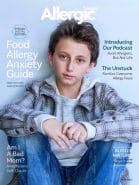 The writer on a fruit-free trip to Thailand.
The writer on a fruit-free trip to Thailand. Accepting my diagnosis was easy, convincing others that I couldn’t eat raw fruits and vegetables was harder.
AFTER years of reactions, ranging from itching to unexplained anaphylaxis and trips to the hospital, there was finally an end to the guessing and questions. I had a diagnosis at the age of 24. My allergist explained that I have oral allergy syndrome (OAS).
“You have a severe case of it,” he said. “With your reactions, I highly recommend avoiding all fresh fruits and vegetables, indefinitely.”
“Indefinitely? Like, forever?” My allergist nodded and brought out a long chart that listed the various fruits and vegetables that I was allergic to. This was in addition to my previously diagnosed nut allergy and environmental allergies to trees, grasses, cats and horses.
Mild vs. Severe Syndrome
Learning that I had OAS came as a bit of a shock, but it was also good to have an explanation at last as to why I couldn’t eat certain things without my throat itching or starting to close up.
The allergist explained that many people have milder version of the syndrome – without even realizing it. Unfortunately, I had a severe case and would most likely never grow out of it. He also said that many people who experience severe hay fever as kids, as I had, develop OAS once they are adults.
OAS, which is also known as pollen-food syndrome, is caused when people first become allergic to inhaled pollens and then later begin to cross-react to when eating various raw fruits, vegetables and nuts. To the immune system, allergenic proteins in those foods appear similar to the pollen allergens.
Cross-reactions can occur with three different types of pollen. Birch pollen can set off symptoms to a long list that includes carrots, celery, apples, cherries, hazelnuts, peaches and kiwi. Ragweed may cross-react with proteins in cucumbers, melons, bananas or zucchini. And grass pollen can take a bite out of summer by triggering responses to food including oranges, tomatoes, peas and watermelons.
Skeptical Friends and Family
The interesting part about the condition is that most people with it can eat fruits and vegetables after they have been cooked. These pollen-related proteins can be killed by heat (which is not the case with other food allergies). So having canned, cooked or steamed fruits and veggies are still options for many.
In my case, I have to be really careful that these items are cooked to well done. Otherwise, boom – another serious reaction!
Oddly, the easiest part of my diagnosis was coming to terms with it. The hard part has been convincing friends, family and co-workers of why I couldn’t eat certain raw foods.
At first, I got looks as if I was crazy. The diagnosis seemed far-fetched. How could it be possible to be allergic to so many healthy and natural things? People have even offered to help me adjust my diet or “heal the bacteria in my gut” to fix me. They mean well, but my issue isn’t fixable.
Once I had the proper diagnosis, I simply wanted to be understood. I didn’t want anyone to think I was making it up or being dramatic – but even 10 years after my condition was confirmed, this still happens occasionally.
Yet the worst part about my condition is thinking you’ve done everything in your power to prevent a reaction – and then having one. It still happens on occasion, and it’s usually when I have gone out to eat, or attend a dinner with friends or family. The mere act of cutting vegetables can make my hands and arms break out in a rash.
The Challenge of Summer
For me, summer is always a bit challenging. At barbecues or get-togethers, fruits and vegetables tend to be a popular side dish to meals. They’re even the theme of many festivals. This can make it difficult to enjoy myself without worrying that I might have a reaction to what someone nearby is eating or that I may accidentally eat something I shouldn’t. I have to remember to carry an epinephrine auto-injector with me at all times, as well as antihistamines.
I also have to remind myself that it’s OK and necessary to ask questions. For me, that has always been one of the hardest parts about the diagnosis. I sometimes feel guilt or shame when asking people about ingredients or how my food was prepared.
It’s hard enough finding something I can eat without the extra helping of disbelief. I want my allergies to be met with understanding – like gluten intolerance or a nut allergy – not with odd looks or questions.
My hope is that one day, OAS will be a widely acknowledged condition, since most of us who have it, have it indefinitely. Like, forever.
Felicia Sabartinelli is a writer, photographer and actress based in Delta, Colorado. Visit her website.

Struggling with Anxiety?
Then get Allergic Living’s “Food Allergy Anxiety Guide.” This e-magazine is an unprecedented exploration of the stresses of life with severe food allergies. The Guide features superb advice from leading experts. An essential primer on the road to getting ‘unstuck’ from allergy fears. Preview it here.
Read more:
All About Oral Allergy Syndrome
My Daughter Has a Food Allergy, But She is Not “A Sufferer”
Bride’s Close Call: Wedding Caterer Oversells Nut-Free Promises





